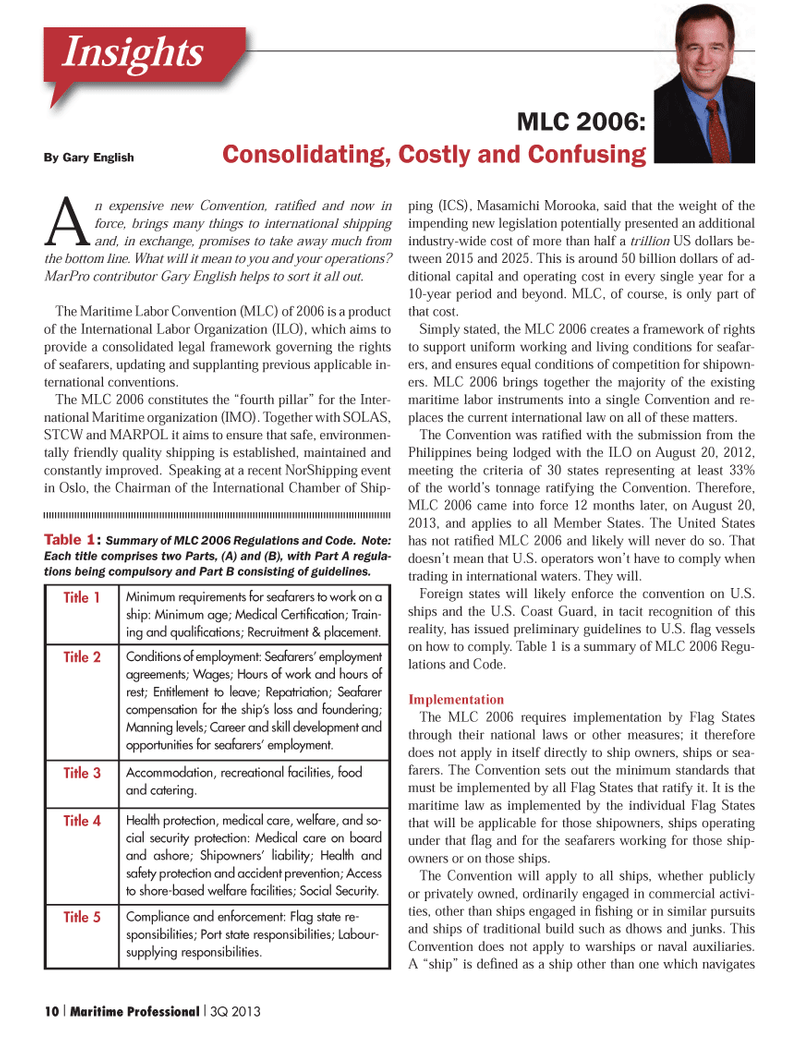
Page 10: of Maritime Logistics Professional Magazine (Q3 2013)
Training & Security
Read this page in Pdf, Flash or Html5 edition of Q3 2013 Maritime Logistics Professional Magazine
MLC 2006: Consolidating, Costly and Confusing By Gary EnglishInsightsAn expensive new Convention, ratiÞ ed and now in force, brings many things to international shipping and, in exchange, promises to take away much from the bottom line. What will it mean to you and your operations? MarPro contributor Gary English helps to sort it all out. The Maritime Labor Convention (MLC) of 2006 is a product of the International Labor Organization (ILO), which aims to provide a consolidated legal framework governing the rights of seafarers, updating and supplanting previous applicable in- ternational conventions. The MLC 2006 constitutes the ?fourth pillar? for the Inter- national Maritime organization (IMO). Together with SOLAS, STCW and MARPOL it aims to ensure that safe, environmen- tally friendly quality shipping is established, maintained and constantly improved. Speaking at a recent NorShipping event in Oslo, the Chairman of the International Chamber of Ship-ping (ICS), Masamichi Morooka, said that the weight of the impending new legislation potentially presented an additional industry-wide cost of more than half a trillion US dollars be-tween 2015 and 2025. This is around 50 billion dollars of ad- ditional capital and operating cost in every single year for a 10-year period and beyond. MLC, of course, is only part of that cost.Simply stated, the MLC 2006 creates a framework of rights to support uniform working and living conditions for seafar- ers, and ensures equal conditions of competition for shipown- ers. MLC 2006 brings together the majority of the existing maritime labor instruments into a single Convention and re- places the current international law on all of these matters. The Convention was rati ed with the submission from the Philippines being lodged with the ILO on August 20, 2012, meeting the criteria of 30 states representing at least 33% of the world?s tonnage ratifying the Convention. Therefore, MLC 2006 came into force 12 months later, on August 20, 2013, and applies to all Member States. The United States has not rati ed MLC 2006 and likely will never do so. That doesn?t mean that U.S. operators won?t have to comply when trading in international waters. They will. Foreign states will likely enforce the convention on U.S. ships and the U.S. Coast Guard, in tacit recognition of this reality, has issued preliminary guidelines to U.S. ag vessels on how to comply. Table 1 is a summary of MLC 2006 Regu- lations and Code.ImplementationThe MLC 2006 requires implementation by Flag States through their national laws or other measures; it therefore does not apply in itself directly to ship owners, ships or sea- farers. The Convention sets out the minimum standards that must be implemented by all Flag States that ratify it. It is the maritime law as implemented by the individual Flag States that will be applicable for those shipowners, ships operating under that ag and for the seafarers working for those ship- owners or on those ships. The Convention will apply to all ships, whether publicly or privately owned, ordinarily engaged in commercial activi- ties, other than ships engaged in shing or in similar pursuits and ships of traditional build such as dhows and junks. This Convention does not apply to warships or naval auxiliaries. A ?ship? is de ned as a ship other than one which navigates Title 1Minimum requirements for seafarers to work on a ship: Minimum age; Medical CertiÞ cation; Train- ing and qualiÞ cations; Recruitment & placement. Title 2Conditions of employment: SeafarersÕ employment agreements; Wages; Hours of work and hours of rest; Entitlement to leave; Repatriation; Seafarer compensation for the shipÕs loss and foundering; Manning levels; Career and skill development and opportunities for seafarersÕ employment. Title 3Accommodation, recreational facilities, food and catering.Title 4Health protection, medical care, welfare, and so-cial security protection: Medical care on board and ashore; ShipownersÕ liability; Health and safety protection and accident prevention; Access to shore-based welfare facilities; Social Security. Title 5Compliance and enforcement: Flag state re-sponsibilities; Port state responsibilities; Labour- supplying responsibilities.Table 1 : Summary of MLC 2006 Regulations and Code. Note: Each title comprises two Parts, (A) and (B), with Part A regula- tions being compulsory and Part B consisting of guidelines. 10 I Maritime Professional I 3Q 2013MP #3 1-17.indd 10MP #3 1-17.indd 109/10/2013 10:36:57 AM9/10/2013 10:36:57 AM

 9
9

 11
11
